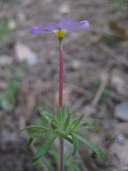|
|
click photo for larger file

Leptosiphon androsaceus
|
Photographer: Julie Kierstead
ID: 0000 0000 0609 0942 (2009-06-05)Copyright © 2009 Julie Kierstead Nelson
|
|
|
Reviewers' comments about this photo (review or add another comment)
| 1. | Reviewed by Randall Morgan Nov 25, 2012 |
| Action: changed name from "Linanthus parviflorus" to "Leptosiphon sp.
" |
| Reviewer's comments: | | | | "If this is L. parv. it looks peculiar. Did you collect specimens or could you describe the loc., habitat etc.?" |
|
| 2. | Reviewed by Randall Morgan Dec 1, 2012 |
| Action: changed name from "Leptosiphon sp." to "Leptosiphon androsaceus
" |
| Reviewer's comments: | | | | "This population has been vouchered several times (Oswald, Ahart et al.) and keyed to L. parviflorus and L. latisectus but matches neither in morphology or in distribution. Lavender forms of parviflorus have not been found north of Monterey County, and the nearest parv of any kind is in Butte Co. and is always white. This location is also far north and east of most L. androsaceus but is clearly that species (lavender corolla with bicolored throat, stigma scarcely or not exserted, heads few-fld. and leaflets few and broad in middle. In fact it closely matches populations from the southern end of the species' range rather than the northern form, right down to the (apparently) pubescent calyces of at least some plants - this could be the reason it was keyed to L. parvif. If the calyx is actually glandular as well it would be strange, but still L. androsaceus nonetheless. It would also not be surprising if this colony is in part shade, another way L. andr. differs from the other 2 species. The southern morphol. affinities of this plant gives cause to wonder about its origins...possibly even introduced? In any case this appears to be the only record for L. andr. from Shasta Co., but same would be true also of L. latisectus or L. parviflorus. Coincidentally, Butte Co. also has a single, even more "extralimital" record of L. andro., at Ahart Ranch (now extirpated by grass competition). This picture really had me confused for a while." |
|
|
|
Using this photo The thumbnail photo (128x192 pixels) on this page may be freely used for personal or academic purposes without prior permission under the Fair Use provisions of US copyright law as long as the photo is clearly credited with © 2009 Julie Kierstead Nelson.
For other uses, or if you have questions, contact Julie Kierstead daffodil.jones[AT]gmail.com. (Replace the [AT] with the @ symbol before sending an email.) |
|
|
